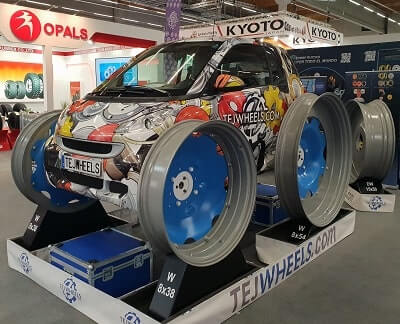Overview of the different rim types
Rims today are made of either steel, light metal or composite materials. Car rims are rolled, cast or forged. There are one-piece rims and multi-piece rims. Light alloy rims usually look more beautiful and are lighter, which is why they're mostly used in e-cars.Rims are available for different types of use:
- bicycle
- motorbike
- commercial vehicles
- car
A wheel is a circular object that rotates around an axle and is used to facilitate transportation of heavy objects. It was invented in ancient times and is considered one of the most important inventions in human history. Wheels are made from a variety of materials, including wood, metal, and plastic, and come in many different sizes and shapes to suit different needs. They can be found on vehicles such as cars, trucks, and buses, as well as on bicycles, carts, and other mobile devices. The shape and design of a wheel can impact its performance, including factors such as traction, durability, and speed.
A rim is the outer edge of a wheel that holds the tire in place and helps to maintain its shape. It is a key component of a wheel and is typically made from metal, such as aluminum or steel. The size and style of a rim can affect the appearance and performance of a vehicle. For example, larger rims can provide a more aggressive look and improved handling, while lightweight rims can improve acceleration and fuel efficiency. Rims are available in a variety of designs, including standard, sport, and luxury styles, and can be customized to suit individual preferences. Additionally, some rims are designed specifically for high-performance or off-road driving, with features such as reinforced construction and unique patterns to provide enhanced traction and durability.
Some technical aspects of rims:- Width: Refers to the distance between the inside edges of the rim and affects tire fit and stability.
- Bolt pattern: Refers to the number of bolts and their arrangement that hold the rim to the vehicle's hub.
- Offset: The distance between the centerline of the wheel and the mounting surface of the hub, which affects the vehicle's handling and stability.
- Lip: The outer edge of the rim that protrudes beyond the tire bead and gives the wheel a finished look.
- Load capacity: The maximum weight the rim can safely support, which is determined by its size, material, and design.
- Center bore: The size and shape of the hole in the center of the rim that fits onto the hub.
- Backspacing: The distance from the inside edge of the rim to the mounting surface, which impacts tire clearance and handling.
- Valve stem: A small valve that allows air to be added or removed from the tire, and is usually mounted in the rim.
These technical specifications are important for selecting the correct rims for a vehicle, as a mismatched rim can affect the vehicle's performance and safety.
Rims come in a variety of designs:
- Multi-spoke: A classic design with multiple thin spokes that converge at the center of the wheel.
- Mesh: A style featuring interlocking metal bars that create a diamond-shaped pattern.
- Concave: A design with an inward curve that gives the wheel a deeper profile and enhances its appearance.
- Deep dish: A style with a pronounced lip that extends far beyond the tire, giving the wheel a dramatic look.
- Forged: A manufacturing process that shapes metal under high pressure to create a strong and lightweight wheel.
- Custom painted: Rims that have been specially painted or coated to match or contrast with the vehicle's color.
- Chrome-plated: A popular design featuring a bright, reflective finish created by applying a layer of chromium to the metal surface.
These designs can add style and personalization to a vehicle, and some also improve performance by reducing weight or improving aerodynamics. However, it is important to make sure the selected design is compatible with the vehicle's specifications and meets all safety requirements.
Rims can be made from a variety of materials:
- Steel: Strong and durable, but heavier than other materials, making it a good choice for heavy-duty vehicles.
- Aluminum: Lightweight and corrosion-resistant, making it a popular choice for performance vehicles.
- Magnesium: Extremely lightweight, but also expensive and more brittle than other materials, making it rarer in the market.
- Carbon fiber: Extremely light and strong, with a unique appearance, making it a popular choice for high-end and racing vehicles.
- Titanium: Lightweight, strong and resistant to corrosion, but also expensive, making it less common in the market.
The choice of material depends on factors such as the intended use, driving conditions, budget, and personal preference. Steel rims are often less expensive, while aluminum and carbon fiber rims are more expensive but offer improved performance and aesthetics.

What we offer
Rim - Car - configurator
Complete wheels aluminium and steel
AEZ
Alcar
Alutec
ATS
AUTEC
AVUS
axxion
BBS
borbet
lump
CARMANI
CMS
DBV
Discreet
THE WHEELS DOTZ
ENZO
GMP
HRE
KESKIN
MAK
MAM
mefro
masterpiece
MSW
MWD
NB Wheels
OXIGIN
OXXO
OZ
PLATINUM
proline
RACER
RC design
RH aluminium wheel rial
ronal
RONDEL
TEC Speedwheels
TOMASON
ultra wheels
V1 Wheels
WheelWorld
